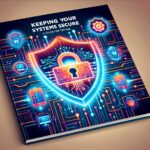Welcome, tech-savvy friends! Today, we’re going to talk about a topic that is near and dear to our hearts: computer security. As we spend more and more of our lives online, it’s crucial to take the necessary steps to protect our sensitive information from prying eyes and malicious hackers. Let’s dive in and explore some key strategies for keeping your data safe.
Introduction to Computer Security
Computer security is the practice of protecting your digital assets from unauthorized access, use, disclosure, disruption, modification, or destruction. This includes both the hardware and software components of your computer system, as well as the data that is stored within it.
In today’s interconnected world, where we rely on computers for everything from communication to banking to entertainment, the stakes are higher than ever when it comes to security. A single breach can result in financial loss, identity theft, or even the compromise of national security.
Common Threats and Risks
There are a variety of threats that can compromise the security of your computer system. Some common examples include malware, phishing attacks, ransomware, and social engineering tactics. These threats can come from a variety of sources, including malicious hackers, organized crime groups, and even nation-states.
Malware, which includes viruses, worms, and Trojans, is one of the most common threats that computer users face. Malware is designed to infiltrate your computer system and steal sensitive information, disrupt your system’s operations, or even take control of your computer.
Phishing attacks are another common threat that targets individuals by sending fake emails or messages that appear to be from legitimate sources, such as your bank or a trusted organization. These messages often contain links or attachments that, when clicked on, can install malware on your system or trick you into revealing sensitive information.
Ransomware is a particularly insidious form of malware that encrypts your files and demands payment in exchange for the decryption key. Once your files are encrypted, there is no way to recover them without paying the ransom, making ransomware a significant threat to individuals and organizations alike.
Best Practices for Computer Security
Now that we’ve covered some of the common threats and risks to computer security, let’s discuss some best practices for keeping your data safe. Here are a few key strategies to consider:
-
Keep your software up to date: Software vendors regularly release updates that patch security vulnerabilities and improve the overall security of their products. Make sure to install these updates as soon as they become available to protect your system from known exploits.
-
Use strong, unique passwords: Passwords are the first line of defense against unauthorized access to your computer system. Use complex passwords that are at least 12 characters long and include a mix of letters, numbers, and special characters. Avoid using easily guessable passwords, such as “password123” or “qwerty.”
-
Enable two-factor authentication: Two-factor authentication adds an extra layer of security to your accounts by requiring a second form of verification, such as a text message or a biometric scan, in addition to your password. This can help prevent unauthorized access to your accounts even if your password is compromised.
-
Be cautious of suspicious emails and links: Phishing attacks often rely on tricking individuals into clicking on malicious links or downloading infected attachments. Be skeptical of emails that ask you to provide sensitive information or urge you to take immediate action. When in doubt, contact the sender directly to verify the authenticity of the message.
-
Back up your data regularly: In the event of a security breach or data loss, having a recent backup of your files can be a lifesaver. Make sure to back up your data regularly to an external hard drive or cloud storage service to protect against data loss.
Conclusion
In conclusion, computer security is a critical component of our modern digital lives. By following best practices such as keeping your software up to date, using strong passwords, enabling two-factor authentication, being cautious of suspicious emails and links, and backing up your data regularly, you can significantly reduce the risk of falling victim to cyber threats.
Remember, it’s always better to be safe than sorry when it comes to protecting your sensitive information. By taking proactive steps to secure your computer system, you can enjoy peace of mind knowing that your data is safe from harm. Stay vigilant, stay informed, and stay secure!
Happy computing!










